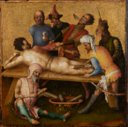According to the latest research, the Lochner family may have come from Hagnau or Lindau on Lake Constance, where the unusual surname is repeatedly documented. In sources from Cologne, Lochner is twice identified as a "painter from Constance", so he must have completed his apprenticeship or even directed his own workshop there. Nothing is known about his journeyman years, but his painting style suggests a close familiarity with early Netherlandish painting. Lochner is first mentioned in Cologne in June 1442, when the city council paid him for painted decorations on the occasion of the ceremonial entry of Emperor Frederick III. In October of that same year he and his wife, Lysbeth, bought the house Roggendorp. Two years later, the couple sold the property and acquired the houses zum Alden Gryne and zum Carbunckel near St Alban, taking out a mortgage. It was only in 1447 that Lochner attained citizenship, possibly because he was about to be elected a councilman. In 1450, after the obligatory three-year interval between candidacies, he was elected to the council for a second time. In August 1451 the Cologne council wrote to Meersburg requesting that the estate of Lochner's deceased parents be secured, explaining that the painter was unable to travel and assume his inheritance himself. A month later a plague cemetery was established next to his house, since the St Alban churchyard was no longer adequate given the epidemic raging in Cologne. By the end of the year the painter and his wife must also have fallen victim to the plague, for on 7 January 1452 their two houses were claimed by one of their creditors. As the owner of several properties and a two-time councilman, Stefan Lochner was the most respected and successful Cologne painter of his time. Although no verified work by his hand has survived, Albrecht Dürer paid a gratuity "to have the panel unlocked that Master Steffan made in Cologne" on his journey to the Netherlands in 1520. In 1822 Johanna Schopenhauer was the first to associate this notation with the monumental altarpiece depicting the city's patrons. Originally from the council chapel, this work is now in the Cologne Cathedral. Her suggestion came to be accepted by scholars; only recently has it been challenged, though without definite proof. Critics of the theory have ultimately only recalled the doubts shared by the second advocate of the theory, Friedrich Böhmer, when he wrote in 1823, "Here we can speak only of probabilities." Yet probability certainly suggests that the most beautiful group of Cologne paintings from the second quarter of the fifteenth century are the work of the city's most important painter, who died shortly after the middle of the century. The core of the group includes, in addition to the cathedral picture, the 'Madonna' in Rosenhag; the 'Last Judgement' in the Wallraf-Richartz-Museum; the Frankfurt apostle martyrdoms and their detached outer sides in Munich; and two dated works, the 'Presentation in the Temple' from 1445 in Lisbon's Gulbenkian Museum, which once belonged with the Munich 'Nativity', and the Darmstadt 'Presentation' from 1447. Stefan Lochner also illuminated two books of hours, now in Berlin and Darmstadt; these can be dated on the basis of their feast-day computations to the years 1444 and 1451.
![Martyrdom of Ss Simon and Judas, Stefan Lochner]()
![Martyrdom of St Andrew, Stefan Lochner]()
![Martyrdom of St Bartholomew, Stefan Lochner]()
![Martyrdom of St James the Elder, Stefan Lochner]()
![Martyrdom of St James the Younger, Stefan Lochner]()
![Martyrdom of St. John the Evangelist, Stefan Lochner]()
![Martyrdom of St Matthew, Stefan Lochner]()
![Martyrdom of St Matthias, Stefan Lochner]()
![Martyrdom of St Paul, Stefan Lochner]()
![Martyrdom of St Peter, Stefan Lochner]()
![Martyrdom of St Philip, Stefan Lochner]()
![Martyrdom of St Thomas, Stefan Lochner]()
![Two altarpiece wings with the Martyrdom of the Apostles, Stefan Lochner]()













